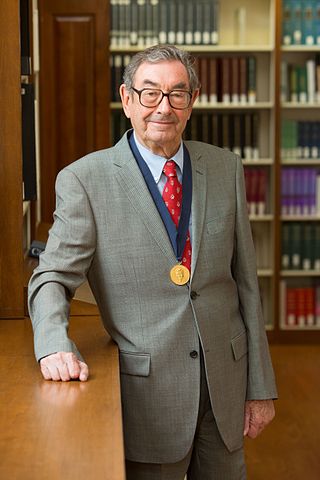Related Research Articles

Sir Joseph John Thomson was a British physicist and Nobel Laureate in Physics, credited with the discovery of the electron, the first subatomic particle to be found.

Ernst August Friedrich Ruska was a German physicist who won the Nobel Prize in Physics in 1986 for his work in electron optics, including the design of the first electron microscope.

Martin Charles Gutzwiller was a Swiss-American physicist, known for his work on field theory, quantum chaos, and complex systems. He spent most of his career at IBM Research, and was also an adjunct professor of physics at Yale University.

Kai Manne Börje Siegbahn was a Swedish physicist who shared the 1981 Nobel Prize in Physics.

Rudolph Arthur Marcus is a Canadian-born U.S. chemist who received the 1992 Nobel Prize in Chemistry "for his contributions to the theory of electron transfer reactions in chemical systems". Marcus theory, named after him, provides a thermodynamic and kinetic framework for describing one electron outer-sphere electron transfer. He is a professor at Caltech, Nanyang Technological University, Singapore and a member of the International Academy of Quantum Molecular Science.

Wolfgang Paul was a German physicist, who co-developed the non-magnetic quadrupole mass filter which laid the foundation for what is now called an ion trap. He shared one-half of the Nobel Prize in Physics in 1989 for this work with Hans Georg Dehmelt; the other half of the Prize in that year was awarded to Norman Foster Ramsey, Jr.

Thomas Eugene Everhart FREng is an American educator and physicist. His area of expertise is the physics of electron beams. Together with Richard F. M. Thornley he designed the Everhart–Thornley detector. These detectors are still in use in scanning electron microscopes, even though the first such detector was made available as early as 1956.

Henry Taube, was a Canadian-born American chemist who was awarded the 1983 Nobel Prize in Chemistry for "his work in the mechanisms of electron-transfer reactions, especially in metal complexes." He was the second Canadian-born chemist to win the Nobel Prize, and remains the only Saskatchewanian-born Nobel laureate. Taube completed his undergraduate and master's degrees at the University of Saskatchewan, and his PhD from the University of California, Berkeley. After finishing graduate school, Taube worked at Cornell University, the University of Chicago and Stanford University.

Clinton Joseph Davisson was an American physicist who won the 1937 Nobel Prize in Physics for his discovery of electron diffraction in the famous Davisson–Germer experiment. Davisson shared the Nobel Prize with George Paget Thomson, who independently discovered electron diffraction at about the same time as Davisson.

Hans Georg Dehmelt was a German and American physicist, who was awarded a Nobel Prize in Physics in 1989, for co-developing the ion trap technique with Wolfgang Paul, for which they shared one-half of the prize. Their technique was used for high precision measurement of the electron magnetic moment.
Haroon Ahmed FREng, is a British Pakistani scientist in specialising the fields of microelectronics and electrical engineering. He is Emeritus Professor of Microelectronics at the Cavendish Laboratory, the Physics Department of the University of Cambridge, Honorary Fellow of Corpus Christi College, Cambridge, and Fellow of the Royal Academy of Engineering.

David James Thouless was a British condensed-matter physicist. He was the winner of the 1990 Wolf Prize and a laureate of the 2016 Nobel Prize for physics along with F. Duncan M. Haldane and J. Michael Kosterlitz for theoretical discoveries of topological phase transitions and topological phases of matter.
Charles August Kraus was an American chemist. He was professor of chemistry and director of the chemical laboratories at Clark University, where he directed the Chemical Warfare Service during World War I.

Harry Barkus Gray is the Arnold O. Beckman Professor of Chemistry at California Institute of Technology.

John Michael Kosterlitz is a Scottish-American physicist. He is a professor of physics at Brown University and the son of biochemist Hans Kosterlitz. He was awarded the 2016 Nobel Prize in physics along with David Thouless and Duncan Haldane for work on condensed matter physics.
Knut W. Urban is a German physicist. He has been the Director of the Institute of Microstructure Research at Forschungszentrum Jülich from 1987 to 2010.

Gerald Edward Brown was an American theoretical physicist who worked on nuclear physics and astrophysics. Since 1968 he had been a professor at the Stony Brook University. He was a distinguished professor emeritus of the C. N. Yang Institute for Theoretical Physics at Stony Brook University.

Ondrej L. Krivanek is a Czech/British physicist resident in the United States, and a leading developer of electron-optical instrumentation. He won the Kavli Prize for Nanoscience in 2020 for his substantial innovations in atomic resolution electron microscopy.
John Joseph Quinn was an American theoretical physicist as well as an academic administrator; he was a former Chancellor and a member of the faculty at The University of Tennessee, Knoxville, US. He was considered to be an expert in the areas of solid-state physics and many-body theory including two dimensional Composite fermions, low-dimensional systems, quantum Hall effect and nanoscience. Quinn was also one of the first researchers to recognize that physics of ‘two-dimensional electronic systems’ needs to be treated as a professional-sub-specialty.

Jacques Dubochet is a retired Swiss biophysicist. He is a former researcher at the European Molecular Biology Laboratory in Heidelberg, Germany, and an honorary professor of biophysics at the University of Lausanne in Switzerland.
References
- 1 2 Brown University
- ↑ "Can the wave function of an electron be divided and trapped?". Brown University. 2014-10-28.